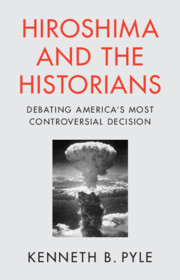42 results
Introduction
-
- Book:
- Hiroshima and the Historians
- Published online:
- 30 May 2024
- Print publication:
- 06 June 2024, pp 1-17
-
- Chapter
- Export citation

Hiroshima and the Historians
- Debating America's Most Controversial Decision
-
- Published online:
- 30 May 2024
- Print publication:
- 06 June 2024
Anything you can do [I can do better]: Exploring women’s agency and gendered protection in state militaries
-
- Journal:
- European Journal of International Security , First View
- Published online by Cambridge University Press:
- 27 May 2024, pp. 1-14
-
- Article
-
- You have access
- Open access
- HTML
- Export citation
B - Strategist Should Be Cheap
-
- Book:
- Three Faces of Sun Tzu
- Published online:
- 07 March 2024
- Print publication:
- 15 February 2024, pp 110-170
-
- Chapter
- Export citation
B - Strategist Should Be Cheap
-
- Book:
- Three Faces of Sun Tzu
- Published online:
- 07 March 2024
- Print publication:
- 15 February 2024, pp 110-170
-
- Chapter
- Export citation
5 - The Impact of the War upon Soldierly Loyalties
-
- Book:
- Black Soldiers in the Rhodesian Army
- Published online:
- 01 February 2024
- Print publication:
- 08 February 2024, pp 143-188
-
- Chapter
- Export citation
Exploring Hindu ethics of warfare: The Purāṇas
-
- Journal:
- International Review of the Red Cross , First View
- Published online by Cambridge University Press:
- 09 January 2024, pp. 1-23
-
- Article
- Export citation
Do Urban City Trauma Centers Suffice as Pre-Deployment Training and Post-Deployment Skills Retaining Centers?
-
- Journal:
- Disaster Medicine and Public Health Preparedness / Volume 17 / 2023
- Published online by Cambridge University Press:
- 10 November 2023, e526
-
- Article
-
- You have access
- Open access
- HTML
- Export citation
9 - Thucydides and War
- from Part II - Themes and Content
-
-
- Book:
- The Cambridge Companion to Thucydides
- Published online:
- 02 March 2023
- Print publication:
- 09 March 2023, pp 129-142
-
- Chapter
- Export citation
6 - The Longest Day in Graignes
-
- Book:
- The Lost Paratroopers of Normandy
- Published online:
- 10 November 2022
- Print publication:
- 10 November 2022, pp 137-162
-
- Chapter
- Export citation
Charting Hinduism's rules of armed conflict: Indian sacred texts and international humanitarian law
-
- Journal:
- International Review of the Red Cross / Volume 104 / Issue 920-921 / August 2022
- Published online by Cambridge University Press:
- 09 September 2022, pp. 1762-1797
-
- Article
- Export citation
Chapter 12 - Can It Become Addictive?
- from Part I - The Factors That Underlie Lust Killing
-
- Book:
- Understanding Sexual Serial Killing
- Published online:
- 26 May 2022
- Print publication:
- 02 June 2022, pp 166-180
-
- Chapter
- Export citation
A Market Review of Available Airway Suction Technology
-
- Journal:
- Prehospital and Disaster Medicine / Volume 37 / Issue 3 / June 2022
- Published online by Cambridge University Press:
- 31 March 2022, pp. 390-396
- Print publication:
- June 2022
-
- Article
- Export citation
The War Is Over but the Moral Pain Continues
-
- Journal:
- Ethics & International Affairs / Volume 36 / Issue 1 / Spring 2022
- Published online by Cambridge University Press:
- 10 March 2022, pp. 7-13
-
- Article
- Export citation
Conclusion
-
- Book:
- The New Art of War
- Published online:
- 12 August 2021
- Print publication:
- 02 September 2021, pp 368-372
-
- Chapter
- Export citation
4 - The Unified War Theory
-
- Book:
- The New Art of War
- Published online:
- 12 August 2021
- Print publication:
- 02 September 2021, pp 193-308
-
- Chapter
- Export citation
Introduction: Why Study War?
-
- Book:
- The New Art of War
- Published online:
- 12 August 2021
- Print publication:
- 02 September 2021, pp 1-5
-
- Chapter
- Export citation
1 - The Origins of War
-
- Book:
- The New Art of War
- Published online:
- 12 August 2021
- Print publication:
- 02 September 2021, pp 6-51
-
- Chapter
- Export citation

The New Art of War
- The Origins, Theory, and Future of Conflict
-
- Published online:
- 12 August 2021
- Print publication:
- 02 September 2021
4 - The Brain Is Not Alone
-
- Book:
- Understanding Animal Behaviour
- Published online:
- 11 May 2021
- Print publication:
- 20 May 2021, pp 61-74
-
- Chapter
- Export citation



